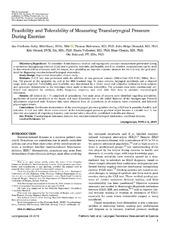| dc.contributor.author | Kelly, Zoe Louise | en_US |
| dc.contributor.author | Halvorsen, Thomas | en_US |
| dc.contributor.author | Heimdal, John-Helge | en_US |
| dc.contributor.author | Strand, Eric | en_US |
| dc.contributor.author | Vollsæter, Maria | en_US |
| dc.contributor.author | Clemm, Hege Synnøve Havstad | en_US |
| dc.contributor.author | Røksund, Ola Drange | en_US |
| dc.date.accessioned | 2019-08-19T12:09:42Z | |
| dc.date.available | 2019-08-19T12:09:42Z | |
| dc.date.issued | 2019 | |
| dc.Published | Kelly ZL, Halvorsen T, Heimdal J, Strand E, Vollsæter M, Clemm H, Røksund OD. Feasibility and tolerability of measuring translaryngeal pressure during exercise. The Laryngoscope. 2019 | eng |
| dc.identifier.issn | 1531-4995 | |
| dc.identifier.issn | 0023-852X | |
| dc.identifier.uri | https://hdl.handle.net/1956/20690 | |
| dc.description.abstract | Objectives/Hypothesis: To determine if simultaneous tracheal and supraglottic pressure measurement performed during a continuous laryngoscopy exercise (CLE) test is possible, tolerable, and feasible, and if so, whether measurements can be used to determined airflow resistance over the larynx, thus providing an objective outcome measure for the CLE test, the gold standard for diagnosing exercise‐induced laryngeal obstruction. Study Design: Explorative descriptive clinical study. Methods: A CLE test was performed with the addition of two pressure sensors (Mikro‐Cath 825‐0101; Millar, Houston, TX) placed at the epiglottic tip and at the fifth tracheal ring. To place sensors, laryngeal anesthesia and a channel scope were required. Tolerability and feasibility was determined by a Likert score and subjective indication from subjects and operators. Adjustments to the technique were made to increase tolerability. The pressure data were continuously collected and analyzed for artifacts, drifts, frequency response, and used with flow data to calculate translaryngeal resistance. Results: All subjects (n = 7) completed all procedures. Two main areas of concern were identified regarding tolerability: application of topical anesthesia to the larynx and nasal discomfort due to the added diameter of the laryngoscope. Protocol adjustments improved both. Pressure data were obtained from all procedures in all subjects, were consistent, and followed physiological trends. Conclusions: Continuous measurement of the translaryngeal pressure gradient during a CLE test is possible, feasible, and tolerable. A CLE test with direct measurement of the translaryngeal pressure gradient might become a valuable tool in the objective assessment of respiratory function, and normal values should be established in health and disease. | en_US |
| dc.language.iso | eng | eng |
| dc.publisher | Wiley | eng |
| dc.rights | Attribution CC BY-NC | eng |
| dc.rights.uri | http://creativecommons.org/licenses/by-nc/4.0/ | eng |
| dc.subject | Translaryngeal resistance | eng |
| dc.subject | exercise test | eng |
| dc.subject | exercise-induced laryngeal obstruction | eng |
| dc.subject | exertional dyspnea | eng |
| dc.title | Feasibility and tolerability of measuring translaryngeal pressure during exercise | en_US |
| dc.type | Peer reviewed | |
| dc.type | Journal article | |
| dc.date.updated | 2019-06-24T12:27:39Z | |
| dc.description.version | publishedVersion | en_US |
| dc.rights.holder | Copyright 2019 The Author(s) | |
| dc.identifier.doi | https://doi.org/10.1002/lary.27846 | |
| dc.identifier.cristin | 1685687 | |
| dc.source.journal | The Laryngoscope | |

